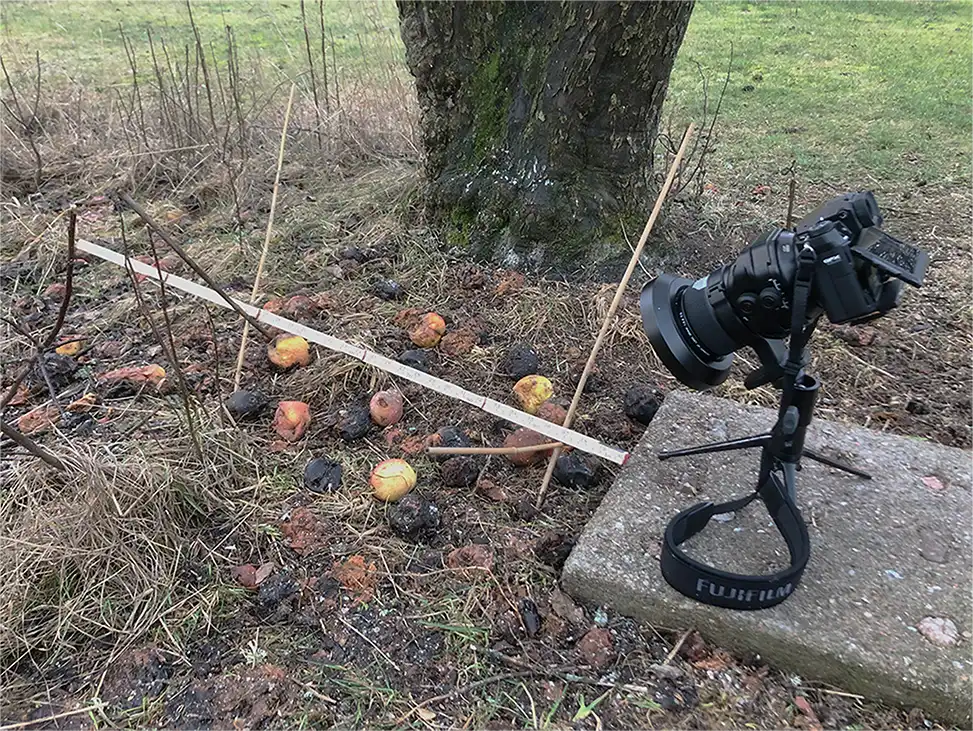
The Crow Project
In december 2024, I finally converted from analog large format to digital medium format. It opened up to whole new kinds of photography.
The Crow Project
In december 2024, I finally converted from analog large format to digital medium format. It
opened up to completely new types of photography. In particular, you can take a lot of
exposures without having to worry about film cost, you get depth of field that you don't
even been able to dream of, and a bunch of technology that helps with exposure, sharpness setting and much more. The stuff weighs a fraction of my old equipment, one can easily carry it all in a backpack. You can even operate the camera through your smartphone!
In order to keep some of my old ways of working, I bought a pair of tilt-shift lenses.
In order to properly get started with everything new, I decided to implement the “Crow Project”.
A couple of crows visit us regularly, they eat fall fruit under the apple trees and sunflower seeds that end up on the ground under the bird table. Crows are highly intelligent birds with great personal integrity. A friend of mine said that crows consider themselves much wiser than humans. Having hung out with them for almost three months, I'm prepared to agree. I wanted to take pictures that showed the crows just as intelligent and sophisticated as they are, pictures with respect for the crow as a thinking creature.
I set the camera up on a small tripod and kept myself hidden a dozen feet away. Apples in
foreground and the crow less then a meter from the camera was the thought. I could have taken hundreds pictures of small birds, they could even sit on camera. The Crows, however, viewed it with great suspicion.

It took like two months before I got the crow in the right position, despite the alluring piles of sunflower seeds behind the apples. After a few days, they began to approach the camera from behind, but they avoided carefully the staring camera eye. When they finally approached from the front, it was with quick rushes to grab some sunflower seeds and then quickly set off again.
After the first few pictures, I switched to a telephoto lens and set the camera a couple of meters away from the scene. Now it became much easier. The Crows were less bothered by the camera. And the telephoto lens, unlike the wide angle, had autofocus that additionally recognized the crow and focused on the eyes. Awesome technique! I just had to wait until the right moment and then pull the trigger.
When I look at the pictures, it is the crow's eyes that touches me the most. The eyes are completely black, no visible pupil or iris, you only see the reflection of the sky and our red cottage. But behind the reflection, a depth opens up that goes all the way into the crow's soul. It's as if it wants to tell us something about humans, and you just have to look around the world now in March 2025, to imagine what it's trying to say.





Small birds willingly allowed themselves to be photographed, worse was the case with crows.
A little about the technology
The first picture with the crow and the apples was a bit of a technical challenge. The idea being to use a wide angle lens and print a really large image, it would give a lot of presence feeling (feel free to read the article and wide angles and perspectives). The crow in the picture is located less than a meter from the camera and the nearest apple no more than 20 cm. With the 30 mm tilt-shift lens, it was possible to lay the plane of focus along the ground, but it was still necessary to step down to f:22 in order for both the ground surface and the apples to be reasonably within
depth of field. Since the apples lie still, I was able to expose for 1 second at ISO 80 and thus get a noise-free image. I then shifted the lens downwards and took another picture to bring in the nearest apples. The overall panoramic image has an angle of view equivalent to roughly a 20mm lens on a full format camera (actually, I took 2x4 exposures with the cameras pixelshift funtion to get all color information in all pixels, the quadruples then was combined in Fujifilm Pixel Shift Combiner). The crow, whose eyes are approximately 15 cm above ground level, was exposed separately. The crow is further from the camera so I thought it would be enough to stop down to f:16 for it to get enough depth-of-field. That meant a boost of ISO to 3200 with a noisy crow and blurry apples as a result. With a shutter speed of a sixtieth of a second I risked some motion blur, but I didn't want to increase the ISO further. The image of the crow was noise-reduced in Lightroom, exported as a dng file and opened in Camera Raw where it was given the same color space as the background apple image (DCam 2, J Holmes). Finally, the crow was fine-tuned in Photoshop and could easily be pasted to the background picture since the the background where identical in the to pictures except for som noise and sharpness. Final adjustments in PS to the finished image.

Preparing for the crow photo shoot. Using a roler and the tilt lens, I set the plane of focus parallel to the ground at crow's eye level. Immediately after I managed to capture the crow, I took new pictures, but now with the plane of sharpness ofn the ground and apples.

First crow ready.
